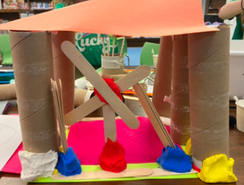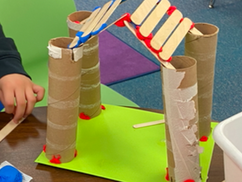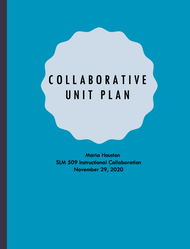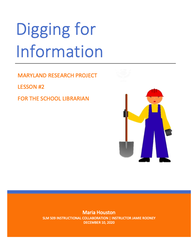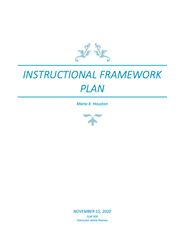Teaching for Learning
Candidates are effective teachers who demonstrate knowledge of learners and learning and who model and promote collaborative planning, instruction in multiple literacies, and inquiry-based learning, enabling members of the learning community to become effective users and creators of ideas and information. Candidates design and implement instruction that engages students interests and develops their ability to think critically, gain and share knowledge.
Candidates are effective teachers who demonstrate knowledge of learners and learning and who model and promote collaborative planning, instruction in multiple literacies, and inquiry-based learning, enabling members of the learning community to become effective users and creators of ideas and information. Candidates design and implement instruction that engages students interests and develops their ability to think critically, gain and share knowledge.
1.1 Knowledge of Learners and Learning
Candidates are knowledgeable of learning styles, stages of human growth and development, and cultural influences on learning. Candidates assess learner needs and design instruction that reflects educational best practice. Candidates support the learning of all students and other members of the learning community, including those with diverse learning styles, physical and intellectual abilities and needs. Candidates base twenty-first century skills instruction on student interests and learning needs and link it to the assessment of student achievement.
Candidates are knowledgeable of learning styles, stages of human growth and development, and cultural influences on learning. Candidates assess learner needs and design instruction that reflects educational best practice. Candidates support the learning of all students and other members of the learning community, including those with diverse learning styles, physical and intellectual abilities and needs. Candidates base twenty-first century skills instruction on student interests and learning needs and link it to the assessment of student achievement.
Description
Save the Pigs was a multi-day collaborative lesson taught with a first-grade educator in the school library. After listening to the story of The Three Little Pigs, learners each designed and built their own house that the Big Bad Wolf could not blow down. This artifact meets Standard 1.1 by utilizing hands-on and developmentally appropriate experiences to support the learning of all members of the learning community.
Analysis
Although I originally planned this lesson for three Media classes, I realized that the learners needed five days: one to listen to the story, one to plan, two to build, test, and revise their homes, and a final day to test. I was amazed that all my learners were engaged in the lesson, regardless of their learning styles, behavior patterns, and physical and intellectual abilities. Typically disruptive or unmotivated learners were on-task during these five lessons. This underscores the importance of hands-on and developmentally appropriate lessons. The weakness of this artifact is the length of time for set up and clean up, which took me away from other library duties.
Reflection
I thoroughly enjoyed watching learners throughout this project. They clearly loved listening to the story, creating their plans, and constructing and testing their houses. I realized how today’s learners still enjoy the classic story of The Three Little Pigs and continue to learn most readily through multi-sensory experiences. While I desire to implement more hands-on literacy experiences in my library program, in the future I will need parent volunteers to help me set up and clean up materials because of my fixed library schedule. With added support, I look forward to incorporating more STEM-based literacy lessons in the future.
Save the Pigs was a multi-day collaborative lesson taught with a first-grade educator in the school library. After listening to the story of The Three Little Pigs, learners each designed and built their own house that the Big Bad Wolf could not blow down. This artifact meets Standard 1.1 by utilizing hands-on and developmentally appropriate experiences to support the learning of all members of the learning community.
Analysis
Although I originally planned this lesson for three Media classes, I realized that the learners needed five days: one to listen to the story, one to plan, two to build, test, and revise their homes, and a final day to test. I was amazed that all my learners were engaged in the lesson, regardless of their learning styles, behavior patterns, and physical and intellectual abilities. Typically disruptive or unmotivated learners were on-task during these five lessons. This underscores the importance of hands-on and developmentally appropriate lessons. The weakness of this artifact is the length of time for set up and clean up, which took me away from other library duties.
Reflection
I thoroughly enjoyed watching learners throughout this project. They clearly loved listening to the story, creating their plans, and constructing and testing their houses. I realized how today’s learners still enjoy the classic story of The Three Little Pigs and continue to learn most readily through multi-sensory experiences. While I desire to implement more hands-on literacy experiences in my library program, in the future I will need parent volunteers to help me set up and clean up materials because of my fixed library schedule. With added support, I look forward to incorporating more STEM-based literacy lessons in the future.
1.2 Effective and Knowledgeable Teacher
Candidates implement the principles of effective teaching and learning that contribute to an active, inquiry-based approach to learning. Candidates make use of a variety of instructional strategies and assessment tools to design and develop digital-age learning experiences and assessments in partnership with classroom teachers and other educators. Candidates can document and communicate the impact of collaborative instruction on student achievement.
Candidates implement the principles of effective teaching and learning that contribute to an active, inquiry-based approach to learning. Candidates make use of a variety of instructional strategies and assessment tools to design and develop digital-age learning experiences and assessments in partnership with classroom teachers and other educators. Candidates can document and communicate the impact of collaborative instruction on student achievement.
Description
To meet Standard 1.2, I created an inquiry-based unit plan for fifth grade—the Maryland Research Project—in collaboration with a classroom educator. Over the course of fourteen lessons taught in the Media Center and the classroom, learners devised a research topic, created a learning goal, located resources, learned to take notes, utilized a graphic organizer, and created a presentation using Adobe Spark or Audacity.
Analysis
I learned that collaborating with a classroom educator fosters a better learning experience than working individually. The greatest strength of this unit plan is it leads learners through the research process. Most fifth-grade learners struggle with taking notes, and this unit plan supports them in learning this concept. However, the greatest weakness of this unit plan is it requires many instructional days to implement. To make this plan more realistic, I need to simplify it and reduce the expectations put on the learners, classroom educator, and school librarian.
Reflection
I enjoyed working with an educator to design a unit plan meeting the specific needs of our learners. This plan teaches fifth-graders how to conduct research. I am proud my plan covers every research skill that learners need to know to be successful in future research. As the school librarian at Twin Ridge Elementary School, I would like to revise this plan in collaboration with a fifth-grade educator in my new learning community. I am also pleased that, without having taught the plan, my experience as a school librarian shows me its weaknesses and informs how I will address those issues in the future.
To meet Standard 1.2, I created an inquiry-based unit plan for fifth grade—the Maryland Research Project—in collaboration with a classroom educator. Over the course of fourteen lessons taught in the Media Center and the classroom, learners devised a research topic, created a learning goal, located resources, learned to take notes, utilized a graphic organizer, and created a presentation using Adobe Spark or Audacity.
Analysis
I learned that collaborating with a classroom educator fosters a better learning experience than working individually. The greatest strength of this unit plan is it leads learners through the research process. Most fifth-grade learners struggle with taking notes, and this unit plan supports them in learning this concept. However, the greatest weakness of this unit plan is it requires many instructional days to implement. To make this plan more realistic, I need to simplify it and reduce the expectations put on the learners, classroom educator, and school librarian.
Reflection
I enjoyed working with an educator to design a unit plan meeting the specific needs of our learners. This plan teaches fifth-graders how to conduct research. I am proud my plan covers every research skill that learners need to know to be successful in future research. As the school librarian at Twin Ridge Elementary School, I would like to revise this plan in collaboration with a fifth-grade educator in my new learning community. I am also pleased that, without having taught the plan, my experience as a school librarian shows me its weaknesses and informs how I will address those issues in the future.
1.3 Instructional Partner
Candidates model, share, and promote effective principles of teaching and learning as collaborative partners with other educators. Candidates acknowledge the importance of participating in curriculum development, of engaging in school improvement processes, and of offering professional development to other educators as it relates to library and information use.
Candidates model, share, and promote effective principles of teaching and learning as collaborative partners with other educators. Candidates acknowledge the importance of participating in curriculum development, of engaging in school improvement processes, and of offering professional development to other educators as it relates to library and information use.
Description
I created a one-day lesson entitled “Digging for Information” as part of a collaborative unit plan. In this lesson, I taught learners how to locate library materials—two digital resources and two print resources—for their Maryland Research Project. The artifact demonstrates Standard 1.3 by using library materials and collaborating with a classroom teacher to create this lesson.
Analysis
“Digging for information” is an important aspect of my collaborative unit plan because it showed learners how to locate the resources required for the Maryland Research Project. My accompanying worksheets scaffolded students through this specific lesson and through the entire unit. The greatest strength of this artifact is that I was able to work with a classroom educator to ensure the lesson I created supported her classroom instruction.
Reflection
I enjoyed working with an educator to support the needs of the learning community. Through creating this artifact, I learned how to simultaneously meet the needs of the classroom educator and the school librarian. I learned that creating SMART objectives ensures that both classroom and library objectives are met in a timely manner. Since the resources in this lesson were based on my previous school’s library collection, I want to revise the resources to align with Twin Ridge Elementary School’s library collection.
I created a one-day lesson entitled “Digging for Information” as part of a collaborative unit plan. In this lesson, I taught learners how to locate library materials—two digital resources and two print resources—for their Maryland Research Project. The artifact demonstrates Standard 1.3 by using library materials and collaborating with a classroom teacher to create this lesson.
Analysis
“Digging for information” is an important aspect of my collaborative unit plan because it showed learners how to locate the resources required for the Maryland Research Project. My accompanying worksheets scaffolded students through this specific lesson and through the entire unit. The greatest strength of this artifact is that I was able to work with a classroom educator to ensure the lesson I created supported her classroom instruction.
Reflection
I enjoyed working with an educator to support the needs of the learning community. Through creating this artifact, I learned how to simultaneously meet the needs of the classroom educator and the school librarian. I learned that creating SMART objectives ensures that both classroom and library objectives are met in a timely manner. Since the resources in this lesson were based on my previous school’s library collection, I want to revise the resources to align with Twin Ridge Elementary School’s library collection.
1.4 Integration
Candidates advocate for twenty-first century literacy skills to support the learning needs of the school community. Candidates demonstrate how to collaborate with other teachers to plan and implement instruction of the AASL Standards for the 21st-Century Learner and state student curriculum standards. Candidates employ strategies to integrate multiple literacies with content curriculum. Candidates integrate the use of emerging technologies as a means for effective and creative teaching and to support P-12 students’ conceptual understanding, critical thinking and creative processes.
Candidates advocate for twenty-first century literacy skills to support the learning needs of the school community. Candidates demonstrate how to collaborate with other teachers to plan and implement instruction of the AASL Standards for the 21st-Century Learner and state student curriculum standards. Candidates employ strategies to integrate multiple literacies with content curriculum. Candidates integrate the use of emerging technologies as a means for effective and creative teaching and to support P-12 students’ conceptual understanding, critical thinking and creative processes.
Description
To demonstrate that I met Standard 1.4, I created an Instructional Framework. The plan—implemented by a fifth-grade educator and school librarian—showcases two activities—Note Taking & Paraphrasing Skills and Creating an Engaging Product—where learners are taught how to effectively paraphrase and summarize important information and learn how to display new knowledge through digital learning technologies.
Analysis
The greatest strength of this artifact is that it outlines how to teach learners the skills required to meet the SMART goals. After sharing the plan with her fifth-grade team, my collaborative partner shared that the educators felt they did not have time to adequately follow each step. In the future, I will ask the educator how much instructional time can be allotted for the activity. I learned that, as a school librarian, I will teach learners these skills throughout the years, so fifth graders will not require as much time to implement all the steps of this lesson plan.
Reflection
I believe this artifact is a powerful example of how the school librarian and classroom teacher can collaborate to meet both library and curricular standards. This exercise showed me how the school community can work together to reach learners. I look forward to making more Instructional Framework Plans, which fosters teamwork between the school librarian and educators.
To demonstrate that I met Standard 1.4, I created an Instructional Framework. The plan—implemented by a fifth-grade educator and school librarian—showcases two activities—Note Taking & Paraphrasing Skills and Creating an Engaging Product—where learners are taught how to effectively paraphrase and summarize important information and learn how to display new knowledge through digital learning technologies.
Analysis
The greatest strength of this artifact is that it outlines how to teach learners the skills required to meet the SMART goals. After sharing the plan with her fifth-grade team, my collaborative partner shared that the educators felt they did not have time to adequately follow each step. In the future, I will ask the educator how much instructional time can be allotted for the activity. I learned that, as a school librarian, I will teach learners these skills throughout the years, so fifth graders will not require as much time to implement all the steps of this lesson plan.
Reflection
I believe this artifact is a powerful example of how the school librarian and classroom teacher can collaborate to meet both library and curricular standards. This exercise showed me how the school community can work together to reach learners. I look forward to making more Instructional Framework Plans, which fosters teamwork between the school librarian and educators.
